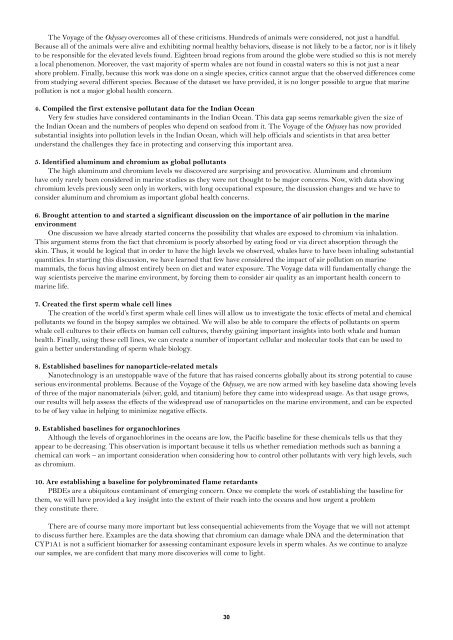Voyage of the Odyssey executive summary - Ocean Alliance
Voyage of the Odyssey executive summary - Ocean Alliance
Voyage of the Odyssey executive summary - Ocean Alliance
Create successful ePaper yourself
Turn your PDF publications into a flip-book with our unique Google optimized e-Paper software.
The <strong>Voyage</strong> <strong>of</strong> <strong>the</strong> <strong>Odyssey</strong> overcomes all <strong>of</strong> <strong>the</strong>se criticisms. Hundreds <strong>of</strong> animals were considered, not just a handful.<br />
Because all <strong>of</strong> <strong>the</strong> animals were alive and exhibiting normal healthy behaviors, disease is not likely to be a factor, nor is it likely<br />
to be responsible for <strong>the</strong> elevated levels found. Eighteen broad regions from around <strong>the</strong> globe were studied so this is not merely<br />
a local phenomenon. Moreover, <strong>the</strong> vast majority <strong>of</strong> sperm whales are not found in coastal waters so this is not just a near<br />
shore problem. Finally, because this work was done on a single species, critics cannot argue that <strong>the</strong> observed differences come<br />
from studying several different species. Because <strong>of</strong> <strong>the</strong> dataset we have provided, it is no longer possible to argue that marine<br />
pollution is not a major global health concern.<br />
4. Compiled <strong>the</strong> first extensive pollutant data for <strong>the</strong> Indian <strong>Ocean</strong><br />
Very few studies have considered contaminants in <strong>the</strong> Indian <strong>Ocean</strong>. This data gap seems remarkable given <strong>the</strong> size <strong>of</strong><br />
<strong>the</strong> Indian <strong>Ocean</strong> and <strong>the</strong> numbers <strong>of</strong> peoples who depend on seafood from it. The <strong>Voyage</strong> <strong>of</strong> <strong>the</strong> <strong>Odyssey</strong> has now provided<br />
substantial insights into pollution levels in <strong>the</strong> Indian <strong>Ocean</strong>, which will help <strong>of</strong>ficials and scientists in that area better<br />
understand <strong>the</strong> challenges <strong>the</strong>y face in protecting and conserving this important area.<br />
5. Identified aluminum and chromium as global pollutants<br />
The high aluminum and chromium levels we discovered are surprising and provocative. Aluminum and chromium<br />
have only rarely been considered in marine studies as <strong>the</strong>y were not thought to be major concerns. Now, with data showing<br />
chromium levels previously seen only in workers, with long occupational exposure, <strong>the</strong> discussion changes and we have to<br />
consider aluminum and chromium as important global health concerns.<br />
6. Brought attention to and started a significant discussion on <strong>the</strong> importance <strong>of</strong> air pollution in <strong>the</strong> marine<br />
environment<br />
One discussion we have already started concerns <strong>the</strong> possibility that whales are exposed to chromium via inhalation.<br />
This argument stems from <strong>the</strong> fact that chromium is poorly absorbed by eating food or via direct absorption through <strong>the</strong><br />
skin. Thus, it would be logical that in order to have <strong>the</strong> high levels we observed, whales have to have been inhaling substantial<br />
quantities. In starting this discussion, we have learned that few have considered <strong>the</strong> impact <strong>of</strong> air pollution on marine<br />
mammals, <strong>the</strong> focus having almost entirely been on diet and water exposure. The <strong>Voyage</strong> data will fundamentally change <strong>the</strong><br />
way scientists perceive <strong>the</strong> marine environment, by forcing <strong>the</strong>m to consider air quality as an important health concern to<br />
marine life.<br />
7. Created <strong>the</strong> first sperm whale cell lines<br />
The creation <strong>of</strong> <strong>the</strong> world’s first sperm whale cell lines will allow us to investigate <strong>the</strong> toxic effects <strong>of</strong> metal and chemical<br />
pollutants we found in <strong>the</strong> biopsy samples we obtained. We will also be able to compare <strong>the</strong> effects <strong>of</strong> pollutants on sperm<br />
whale cell cultures to <strong>the</strong>ir effects on human cell cultures, <strong>the</strong>reby gaining important insights into both whale and human<br />
health. Finally, using <strong>the</strong>se cell lines, we can create a number <strong>of</strong> important cellular and molecular tools that can be used to<br />
gain a better understanding <strong>of</strong> sperm whale biology.<br />
8. Established baselines for nanoparticle-related metals<br />
Nanotechnology is an unstoppable wave <strong>of</strong> <strong>the</strong> future that has raised concerns globally about its strong potential to cause<br />
serious environmental problems. Because <strong>of</strong> <strong>the</strong> <strong>Voyage</strong> <strong>of</strong> <strong>the</strong> <strong>Odyssey</strong>, we are now armed with key baseline data showing levels<br />
<strong>of</strong> three <strong>of</strong> <strong>the</strong> major nanomaterials (silver, gold, and titanium) before <strong>the</strong>y came into widespread usage. As that usage grows,<br />
our results will help assess <strong>the</strong> effects <strong>of</strong> <strong>the</strong> widespread use <strong>of</strong> nanoparticles on <strong>the</strong> marine environment, and can be expected<br />
to be <strong>of</strong> key value in helping to minimize negative effects.<br />
9. Established baselines for organochlorines<br />
Although <strong>the</strong> levels <strong>of</strong> organochlorines in <strong>the</strong> oceans are low, <strong>the</strong> Pacific baseline for <strong>the</strong>se chemicals tells us that <strong>the</strong>y<br />
appear to be decreasing. This observation is important because it tells us whe<strong>the</strong>r remediation methods such as banning a<br />
chemical can work – an important consideration when considering how to control o<strong>the</strong>r pollutants with very high levels, such<br />
as chromium.<br />
10. Are establishing a baseline for polybrominated flame retardants<br />
PBDEs are a ubiquitous contaminant <strong>of</strong> emerging concern. Once we complete <strong>the</strong> work <strong>of</strong> establishing <strong>the</strong> baseline for<br />
<strong>the</strong>m, we will have provided a key insight into <strong>the</strong> extent <strong>of</strong> <strong>the</strong>ir reach into <strong>the</strong> oceans and how urgent a problem<br />
<strong>the</strong>y constitute <strong>the</strong>re.<br />
There are <strong>of</strong> course many more important but less consequential achievements from <strong>the</strong> <strong>Voyage</strong> that we will not attempt<br />
to discuss fur<strong>the</strong>r here. Examples are <strong>the</strong> data showing that chromium can damage whale DNA and <strong>the</strong> determination that<br />
CYP1A1 is not a sufficient biomarker for assessing contaminant exposure levels in sperm whales. As we continue to analyze<br />
our samples, we are confident that many more discoveries will come to light.<br />
30


